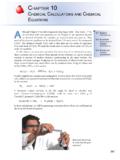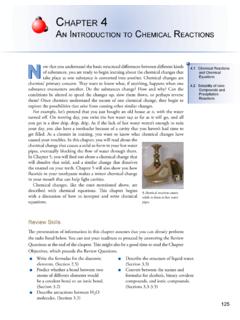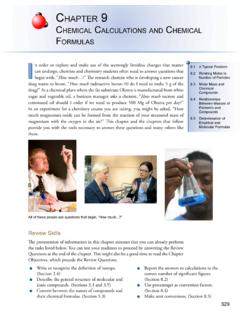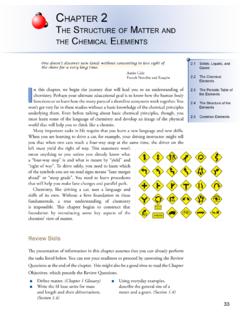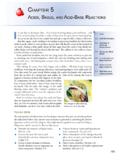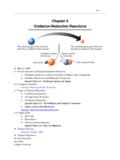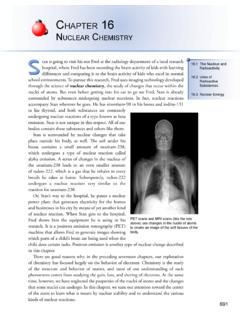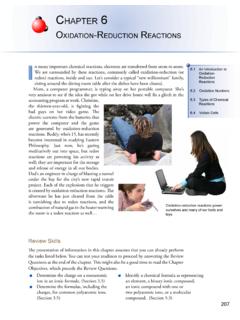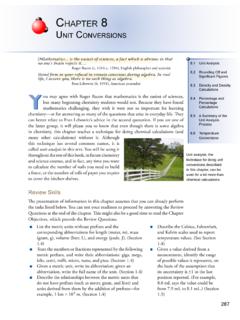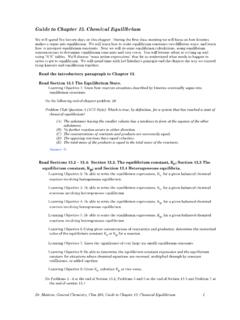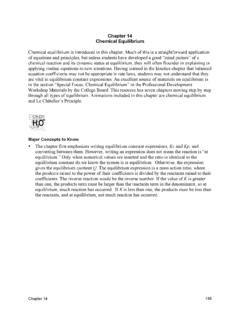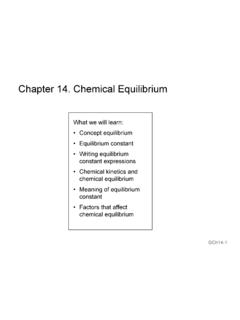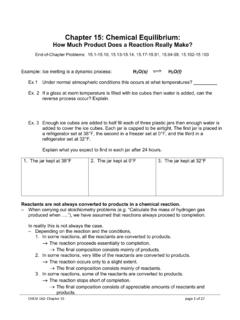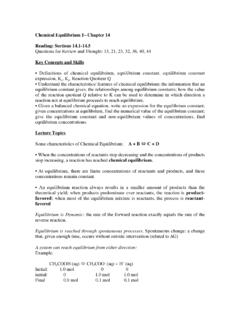Transcription of Chapter 14 - The Process of Chemical Reactions
1 Chapter 14 235 Chapter 14 - The Process of Chemical Reactions Review Skills Collision Theory: A Model for the Reaction Process The Basics of Collision Theory Endergonic Reactions Summary of Collision Theory Rates of Chemical Reactions Temperature and Rates of Chemical Reactions Concentration and Rates of Chemical Reactions Catalysts Homogeneous and Heterogeneous Catalysts Special Topic : Green Chemistry - The Development of New and Better Catalysts Reversible Reactions and Chemical equilibrium Reversible Reactions and Dynamic equilibrium equilibrium Constants Determination of equilibrium Constant Values equilibrium Constants and Extent of Reaction Heterogeneous Equilibria equilibrium Constants and Temperature Internet: Calculating Concentrations and Gas Pressures Internet: pH and pH Calculations Internet: Weak Acids and equilibrium Constants Disruption of equilibrium The Effect of Changes in Concentrations on equilibrium Systems Internet.
2 Changing Volume and Gas Phase equilibrium Le Ch telier s Principle The Effect of Catalysts on Equilibria Special Topic : The Big Question How Did We Get Here? Chapter Glossary Internet: Glossary Quiz Chapter Objectives Review Questions Key Ideas Chapter Problems 236 Study Guide for An Introduction to Chemistry Section Goals and Introductions Section Collision Theory: A Model for the Reaction Process Goals To describe a model, called collision theory, that helps us to visualize the Process of many Chemical Reactions . To use collision theory to explain why not all collisions between possible reactants lead to products.
3 To use collision theory to explain why possible reactants must collide with an energy equal to or above a certain amount to have the possibility of reacting and forming products. To show how the energy changes in Chemical Reactions can be described with diagrams. To use collision theory to explain why possible reactants must collide with a specific orientation to have the possibility of reacting and forming products. Once again, this Chapter emphasizes that if you develop the ability to visualize changes on the particle level, it will help you understand and explain many different things. This section introduces you to a model for Chemical change that is called collision theory, which helps you explain the factors that affect the rates of Chemical Reactions .
4 These factors are described in Section Section Rates of Chemical Reactions Goals To show how rates of Chemical Reactions are described. To explain why increased temperature increases the rates of most Chemical Reactions . To explain why increased concentration of reactants increases the rates of Chemical Reactions . To describe how catalysts increase the rates of certain Chemical Reactions . This section shows how collision theory helps you explain the factors that affect rates of Chemical changes. These factors include amounts of reactants and products, temperature, and catalysts. Section Reversible Reactions and Chemical equilibrium Goals To explain why Chemical Reactions that are reversible come to a dynamic equilibrium with equal forward and reverse rates of reaction.
5 To show what equilibrium constants are and how they can be determined. To describe how equilibrium constants can be used to show the relative amounts of reactants and products in the system at equilibrium . To explain the effect of temperature on equilibrium systems and equilibrium constants. This section takes the basic ideas of dynamic equilibrium introduced in Chapter 12 and applies them to reversible Chemical changes. This is a very important topic, so plan to spend some extra time on this section, if necessary. You will also learn how equilibrium constants are used to describe the relative amounts of reactants and products for a Chemical reaction at Chapter 14 237 equilibrium , and you will learn how these values can be calculated.
6 Finally, you will learn more about the effect of temperature on Chemical changes. See the three related sections on our Web site: Internet: Calculating Concentrations and Gas Pressures Internet: pH and pH Calculations Internet: Weak Acids and equilibrium Constants Section Disruption of equilibrium Goal: To describe how equilibrium systems can be disrupted and show you how to predict whether certain changes on a system at equilibrium will lead to more products, more reactants, or neither. Although the concept of Chemical equilibrium is very important, many reversible Reactions in nature never form equilibrium systems.
7 This section s description of the ways that equilibrium systems can be disrupted will help you to understand why this is true. The ability to predict the effects of changes on equilibrium systems will help you understand the ways that research and industrial chemists create conditions for their Chemical Reactions that maximize the rate at which desirable Reactions move to products and minimize that rate at which undesirable Reactions take place. See the section on our Web site that provides information on Changing Volumes and Gas Phase equilibrium . Internet: Changing Volume and Gas Phase equilibrium 238 Study Guide for An Introduction to Chemistry Chapter 14 Map Chapter 14 239 Chapter Checklist Read the Review Skills section.
8 If there is any skill mentioned that you have not yet mastered, review the material on that topic before reading this Chapter . Read the Chapter quickly before the lecture that describes it. Attend class meetings, take notes, and participate in class discussions. Work the Chapter Exercises, perhaps using the Chapter Examples as guides. Study the Chapter Glossary and test yourself on our Web site: Internet: Glossary Quiz Study all of the Chapter Objectives. You might want to write a description of how you will meet each objective. This Chapter has logic sequences in Figures , , , , and Convince yourself that each of the statements in these sequences logically leads to the next statement.
9 To get a review of the most important topics in the Chapter , fill in the blanks in the Key Ideas section. Work all of the selected problems at the end of the Chapter , and check your answers with the solutions provided in this Chapter of the study guide. Ask for help if you need it. Web Resources Internet: Calculating Concentrations and Gas Pressures Internet: pH and pH Calculations Internet: Weak Acids and equilibrium Constants Internet: Changing Volume and Gas Phase equilibrium Internet: Glossary Quiz Exercises Key Exercise Writing equilibrium Constant Expressions: Sulfur dioxide, SO2, one of the intermediates in the production of sulfuric acid, can be made from the reaction of hydrogen sulfide gas with oxygen gas.
10 Write the equilibrium constant expressions for KC and KP for the following equation for this reaction. (Objs 24 & 25) 2H2S(g) 3O2(g) 2SO2(g) 2H2O(g) 22222222 SOH O22CP232322 HSOP P[SO ] [H O]K = K = [H S] [O ]P P 240 Study Guide for An Introduction to Chemistry Exercise equilibrium Constant Calculation: Ethanol, C2H5OH, can be made from the reaction of ethylene gas, C2H4, and water vapor. A mixture of C2H4(g) and H2O(g) is allowed to come to equilibrium in a container at 110 C, and the partial pressures of the gases are found to be atm for C2H4(g), atm for H2O(g), and atm for C2H5OH(g).
